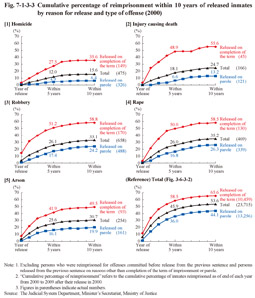3 Reimprisonment status of released inmates
Fig. 7-1-3-3 shows the cumulative percentage of inmates reimprisoned for serious offenses (hereinafter referred to as the “cumulative percentage of reimprisonment” in this subsection) as of end of the each year for the inclusive period of 10 years after being released in 2000 by reason for release (on completion of the term of imprisonment or on parole). The cumulative percentage of reimprisonment within 10 years was low for serious offenses when compared to that of all released inmates (53.6%), being 15.6% for homicide, 24.7% for injury causing death, and 30-40% for robbery, rape, and arson. By reason for release the cumulative percentage of reimprisonment of those released on completion of the term of imprisonment was high at approximately 50-60% for injury causing death (55.6%), robbery (58.8%), rape (58.5%), and arson (49.5%), but excluding homicide (35.6%) (that of all released inmates was 65.6%), and that of those released on parole was quite low for all of homicide (6.4%), injury causing death (13.2%), robbery (24.2%), rape (26.3%), and arson (19.9%) when compared to that of all released inmates (44.1%). The difference between the cumulative percentage of reimprisonment within 10 years of those released on completion of their term of imprisonment and that of those released on parole was generally more than 30 points for all serious offenses, being larger than that of all released inmates (21.5 points).
Fig. 7-1-3-3 Cumulative percentage of reimprisonment within 10 years of released inmates by reason for release and type of offense (2000)
The percentage of those reimprisoned for the first time in the sixth year or later from their release to the cumulative total of those reimprisoned within 10 years was quite high for homicide (23.0%), injury causing death (26.8%), robbery (21.1%), and rape (26.1%), but excluding arson (16.7%), when compared to that of all released inmates (14.3%), thus indicating the long-term continued risk of a repeat offense with these offenses.
